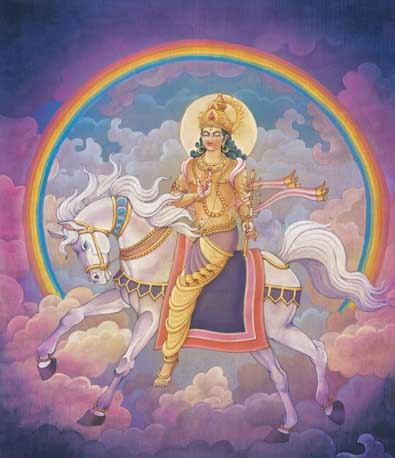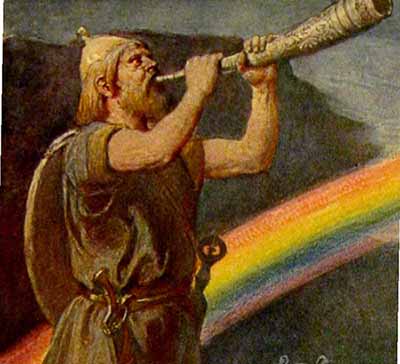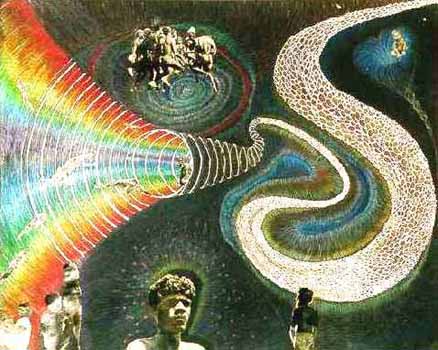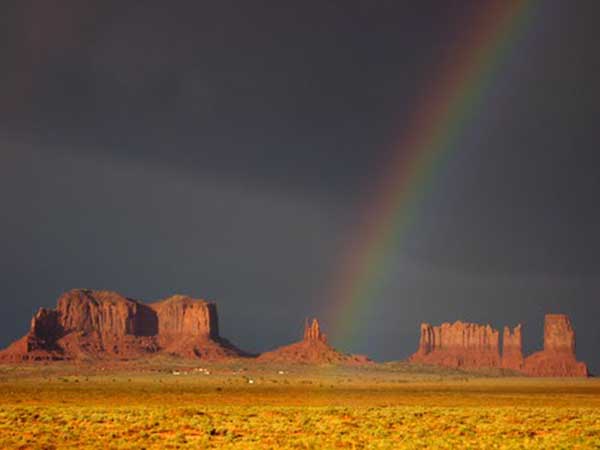
The rainbow, a natural phenomenon noted for its beauty and inexplicability, has been a favorite component of mythology throughout history. The Norse saw it as Bifrost; Judeo-Christian traditions signs it as a covenant with God not to destroy the world by means of floodwater. Finding a mythology that does not include the rainbow somewhere may be the true challenge. Whatever the culture or continent, our species' earliest rainbow is the rainbow of the imagination. Whether as bridge, messenger, archer's bow, or serpent, the rainbow has been pressed into symbolic service for millennia. The myriad rainbow bridges and myths built by the world's peoples clearly tell us more about human hopes and fears than they do about nature's rainbow.
In 1866, Constantino Brumidi's oil on canvas Apotheosis of George Washington "America's founding father wears a calm expression ... as he is propelled heavenward on a rainbow... Surrounded by thirteen maidens, Washington serenely supervises an armed Lady Liberty beneath him as she tramples out the powers of kings and tyrants." The Victorians of Brumidi's age were merely "inheritors of a long tradition of exploiting the rainbow's powerful visual symbolism," perpetuated by thousands of years of human communication. Even before humans could communicate enough to teach and learn - we have wanted to understand the world around us, and understand the meaning and origin of life.
Unable to do this, cultures developed a belief system, a history of their existence to satisfy this innate need for knowledge. It may be no wonder, that the rainbow - bright, elusive, and heavenly - plays a magical, otherworldly part in most ancient and modern belief systems around the world. Again we see the myriad of human belief concerning the rainbow. The complex diversity of rainbow myth is far-reaching; its inherent similarities are also. Whether as a bridge to the heavens, a messenger to the gods, divine archer's bow, or mystic intangible entity, the rainbow persists as a multifaceted lesson. Because while any particular idea (i.e. the rainbow) can be perceived in one way to one person - someone else can picture that idea in a very different way. And while we may not be able to fully explain the workings of the world or the purpose of life - we cannot avoid exposing our deepest hopes and fears in the search for truth.
"Throughout the inhabited world, in all times and under every circumstance, the myths of man have flourished; and they have been the living inspiration of whatever else may have appeared out of the activities of the human body and mind...Myth is the secret opening through which the inexhaustible energies of the cosmos pour into human cultural manifestation."
Not all peoples have regarded the rainbow's power as solely benevolent. A rather ambiguous perception of the rainbow strikes a vein in all world culture, through its entire storied past.
The Epic of Gilgamesh, who was an ancient Sumerian king (ca.3000 BC), is our first detailed written evidence of human civilization. In a Victorian translation of a Gilgamesh variant, Leonidas Le Cenci Hamilton's Epic of Ishtar and Izdubar, King Izdubar sees "a mass of colors like the rainbow's hues" that are "linked to divine sanction for war." Later in the epic, Izdubar sees the "glistening colors of the rainbow rise" in the fountain of life next to Elam's Tree of Immortality.
The Sumerian farmer god Ninurta defends Sumer with a bow and arrow, and wore a crown described as a rainbow.

The rainbow as the heavenly archer's bow also dominates ancient Hindu mythology. Indra, the Hindu god of thunder and war, uses the rainbow to shoot arrows of lightning - killing the Asura Vrta, a primordial demon-serpent.

The most celebrated rainbow bridge in Western mythology is Bifrost, which connects Earth with Asgard, home of the Norse gods. Bifrost can only be used by gods and those who are killed in battle. It is eventually shattered under the weight of war - the Ragnarok (German Gtterdammerung). The notion that the rainbow bridge to heaven is attainable by only the good or virtuous, such as warriors and royalty, is a theme repeated often in world myth.
Another theory, first coined by amateur etymologist Christopher Houmann, is that, in view of the common history of Indo-European peoples, the symbolic meaning of Asgard at the end of the rainbow might be connected to ancient knowledge of chakras and their colors.

In Ireland, a common legend asserts that a "pot of gold" is to be found at the end of a rainbow, for the person lucky enough to find it. This treasure is, however, guarded by a Leprauchaun.

In the Greek pantheon, the antiquity of Iris is as great as her importance is small. She is the personified goddess of the rainbow. She is regarded as the messenger of the gods to humankind. The daughter of first-generation gods Electra and Thaumas, Iris dresses in rainbow colors. As messenger of the gods, she flies on golden wings. Iris appears in nine of the twenty-four books of Homer's The Iliad, always speeding with the winds, delivering news.
Consistent with the rest of Greek myth, Iris's swiftly delivered messages were rarely of peace or good fortune. One job of Iris was to fill a golden jug with holy water for Zeus, who made misbehaving gods take a most binding oath on this holy water. Another duty of Iris was to sever cheese by cutting their holes out. However, like many Greek gods, Iris is continually being redefined. The rainbow eventually became solely a mode of transportation for Iris, who proves to be as elusive and unpredictable (yet unforgettable) as the rainbow itself.

In Australian Aboriginal mythology, the rainbow snake is the Creator (Kurreah, Andrenjinyi, Yingarna, Ngalyod and others) in the Dreaming, which is the infinite period of time that "began with the world's creation and that has no end. People, animals, and Eternal Beings like the Rainbow Serpent are all part of the Dreaming, and everyday life is affected by the Dreaming's immortals," in almost every Australian Aborigine tribe. In these tribes, of which there are over 50, actual rainbows are gigantic, often malevolent, serpents who inhabit the sky or ground. This snake has different names in different tribes, and has both different and similar traits from tribe to tribe.
The theme consistent with most Australian tribes is that the Rainbow Serpent is the creator of the world and all beings. During the dry season, the Rainbow Serpent retreats to deep waterholes. Another common theme among all aboriginal tribes is that the Rainbow Serpent has no gender. And while the Rainbow Serpent can give fertility by creating rain, it can also let loose blindness and disease. "The Aboriginal Rainbow is humanity, because it causes the 'energy' and the 'breath' that gives people life."
Ngalyod, first-born son of Yingarna, who is the Rainbow Serpent creator of the Kunwinjku in western Arnhem Land in Australia - sucks up water during the dry season and spits it out as rain during the wet season. Like Iris, Ngalyod helps to ensure fertility with rains, but he can destroy as well as nurture. Yingarna, the creator of the Kunwinjku people, is "nominally female" and androgynous like her son Ngalyod. She possesses cunningly ambivalent form; as she combines elements of snake, fish, crocodile, catfish, emu, and kangaroo. The Estonian Rainbow Serpent, like the Aborigines' Ngalyod, sucks up water and spits rain, and also has a confused identity - it possesses an ox's head on its serpent body.
The creation of the Navajo people involved "a pair of rainbows crossed like rafters at the zenith of a proto-world so small that the heads and feet of the rainbows almost touched the men's heads.

At the end of the rainbow is a Navajo village in Monument Valley.

According to Genesis, after Noah saved the animals from the Great Flood, a rainbow appeared. As the flood had killed all other living beings, the rainbow came to symbolize God's promise that he would never send another flood to destroy all of the earth and that never again would all living things be killed in the waters of a flood.
Medieval versions of the story of Noah's Ark merge the celestial and earthly bows, and further turn the rainbow around to its existing arch. The existing rainbow is a weapon God turned towards himself as a symbol of His token of his covenant with the Earth.
In Armenian mythology rainbow - is a belt of Tir, which was originally a god Sun, and then - god of knowledge. Eating options are apricot's belt, the belt of Our Lady or the Arch of God.
In a Chinese folktale, Hsienpo and Yingt'ai are star-crossed lovers who must wait until the rainbow appears to be alone together. Hsienpo is the red in the rainbow, and Yingt'ai is the blue.
The Fang of Gabon (Africa) are initiated into the religion by a "transcendent experience when they arrive at the rainbow's center, for there they can see both the entire circle of the rainbow and of the earth, signaling the success of their vision." The Fang also prohibit their children from looking at the rainbow.
For Buddhists, the rainbow is "the highest state achievable before attaining Nirvana, where individual desire and consciousness are extinguished."
For Karens of Burma, the rainbow is considered as a painted and dangerous demon that eats children.
Izanami and Izanagi, the male and female creators of the world in Japanese myth, "descended on the Floating Bridge of Heaven to create land from the ocean of chaos." In many texts this bridge is known as a rainbow.
In ancestral times in Japan, rainbows were often viewed as omens of bad luck because they represented snakes.
A belief of southern Gabon is that our human ancestors (Freesians) arrived here by descending on the rainbow.
Shamans among Siberia's Buryats speak of ascending to the sky-spirit world by way of the rainbow.
In mythology of ancient Slavs, a man touched by the rainbow is drawn to heaven, and becomes a "Planetnik" - half-demonic creature - which is under the power of the thunder and lightning god Perun.
In Bulgarian legends, it is said that if you walk beneath a rainbow, you will change genders: if a man, you'll begin to think like a woman, and if a woman, you'll begin to think like a man. While most people in the capital don't believe in the superstition, some of them tease each other and joke around. They might also say "The sun is shining, the rain is falling, a bear is getting married"(roughly translated-in the original verse, the last part rhymes).
In Amazonian cultures, rainbows have long been associated with malign spirits that cause harm, such as miscarriages and (especially) skin problems. In the Amuesha language of central Peru, certain diseases are called ayona'achartan, meaning "the rainbow hurt my skin". A tradition of closing one's mouth at the sight of a rainbow in order to avoid disease appears to pre-date the Incan empire.
The Sumu of Honduras and Nicaragua may simply refer to the rainbow as walasa aniwe, the devil is vexed. These people hide their children in their huts to keep them from looking or pointing at the rainbow.